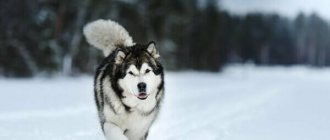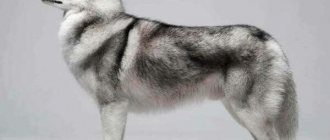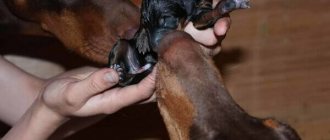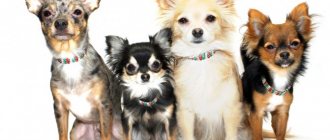Labradors are among the most humane dogs; they are a pet friend, partner, and travel companion.
Labradors are dogs of medium height, they train well, but do not tolerate loneliness well.
Hardy, patient and active pets.
There is a table of sizes that can be used to accurately determine whether everything is in order in the puppy’s development and whether it corresponds to the standard.
How much should an adult pet weigh?
Labradors grow up to a year, after which they practically do not change. Owners only need to worry about maintaining shape.
Labradors are prone to weight gain, and their diet and physical activity must be strictly controlled . Obese dogs experience heart problems.
Labrador boys weigh differently than girls.
For males, the norm is a weight of 28-36 kilograms; for females, a weight from 25 to 33 kilograms is considered normal..
Dimensions (height at withers, etc.) for an adult Labrador, depending on gender
There is an American standard, according to which the height of females is up to 55 centimeters at the withers, males - up to 57 centimeters.
You can measure your dog at home. The breed standards, in addition to general height and weight, include indicators of head length, cheekbone width, length of the body and front legs, chest girth, wrist girth, muzzle length, distance between the shoulder blades, and leg length.
The Labrador is considered a dog of medium height - not very tall and not too small - and quite large in build.
requirements :
- Wedge-shaped large head.
- Powerful muzzle with large nostrils.
- Strong rounded jaws.
- Straight and level nose.
- The eyes are not very big.
- The tail is moderately long, straight, wider at the base and narrower towards the end.
- The hind legs are more developed than the front legs.
If a Labrador's weight exceeds the norm (you can check the size chart and try on the dog yourself at home; on average, an adult dog is about thirty kilograms and half a meter in height), then this cannot be ignored. These dogs have a high appetite, they do not know how to control themselves, and apartment pets most often suffer from obesity. Closer to the age of 10, Labradors become overgrown with fat deposits, this can be avoided if the dog is loaded with physical exercise - running, long walks, swimming - one and a half to two active hours a day. You can check for excess weight by lightly pressing the ribs with your fingers: they should be palpable, but individual ribs should not be visible. If a Labrador does not grow more than forty centimeters for a long time - for example, up to a year - then it is too early to panic, perhaps the dog has not yet matured: adult individuals sometimes grow up to one and a half years.
Health control
Systemic measurements are also relevant for non-show activity: a table of labrador retriever weight gain by month is an excellent tool for monitoring the health of labrador fry. The table showing the growth of a Labrador by month is an indicator of proper development.
Excess fat mass is a common occurrence in Labradors. Cheerful life-lovers are famous for their insatiable appetite and absolute omnivorousness. Obesity is a painful form that requires tough decisions and immediate action: excess weight is harmful to health and shortens a pet’s life expectancy. To diagnose obesity, it is enough to compare the reference age indicators and the results of weighing a toothy pet. If your Labrador’s weight per year exceeds the declared norm by more than fifteen percent, it’s time to urgently contact a veterinarian and nutritionist.
Excess weight that develops into obesity is a serious problem and a source of serious complications. Loss of physical activity creates a “vicious circle”: the dog needs to actively move in order to “throw off” those extra pounds, but the dog cannot do this due to health conditions.
Puppy weight and sizes from 1 to 12 months
The weight of newborn Labradors ranges from 40 to 55 grams . Every day they increase to 120 g. From birth to the first month, puppies grow up to 23 centimeters, at three months they reach 40 centimeters, and by six months - 50 centimeters.
Meeting height and weight standards is necessary because this indicates the health of the puppy, as well as its purebred.
At exhibitions where Labradors are examined by experts, the first thing that is done is weighing and other essential measurements.
Therefore, the owner’s responsibility is not only to raise the pet, but also to monitor how it grows in size, strictly following the required diet.
How to measure height correctly?
You need to use several tools: a centimeter, a ruler, a tape, a square. The height of a dog can be determined by extending a centimeter (tape) along the animal’s body: the end is applied to the floor and extended to the withers.
Height is the distance from the dog's foot to the withers.
Metric information is collected from a standing dog. The animal must be in good spirits and not hungry. The best way to measure a Labrador is at home, in a calm environment; you can cheer him up with a treat.
Gradually the dog will get used to such manipulations and will respond well to them.
The height at the sacrum can be measured with a centimeter (tape, ruler) - from the floor to the highest point of the croup, in maclocs.
To make accurate measurements, the instruments must be placed at the correct points so that they fit against the animal's body, but do not press in. If the hair is long, then to accurately measure growth you need to part the hair and apply a centimeter (ruler, tape) to the skin.
To measure body length, first apply the end of the centimeter to the shoulder, then to the ischial tuberosity. When comparing actual sizes and standards, a special index is used, that is, an indicator of one dog parameter to another.
Growth in this case is the main factor; other results are correlated with it. For example, they distinguish the elongation index (body length to height) and boneiness (carpal girth to height).
IMPORTANT!
Indices allow you to judge whether a four-legged pet meets breed standards.
All data in breed tables are approximate . Sometimes puppies are already fully formed by the age of six months, and often continue to grow after a year.
If the height of a real dog does not coincide with the ideal parameters from the table, then there is nothing to worry about . The totality of all measurements, the general constitution of the dog’s body, is looked at.
This helps to monitor how your pet is developing. It is the height-weight ratio that gives experts an idea of how well developed the dog is, whether its ancestors were purebred Labradors or whether there was a crossbreed during mating.
At exhibitions, any measurements of an animal are allowed only in the presence of the owner . Service dog breeding usually operates with the indices of elongation and boneiness.
To what age do they grow?
There are three stages of maturation and growth of a Labrador puppy:
- The first four months are a pronounced growth.
- From five to eight months – a slowdown in growth rates.
- From nine months to one year – a slight increase in height and weight.
It is believed that from the age of one year dogs can already take part in exhibitions, their body is fully formed. There are three breed standards: international, British and American.
World and English are very close to each other, these are strict standards . They allow deviations from the reference height of up to one centimeter.
The American allows the dog to be three to five centimeters below or above the standard.
The weight of Labradors is not so clearly regulated, the main thing is the ratio of weight and height.
Puppy age
From birth to two weeks of age, a Labrador puppy will be deaf, blind and dependent on its mother. At 2-4 weeks he will be able to see and hear the world around him for the first time, become mobile, and explore smells, sounds and new places. In the fourth week, baby teeth will begin to emerge. And at the age of 8 weeks, the puppy can already be taken from its mother and made into a full-fledged companion and friend.
What affects a puppy’s parameters?
The future weight and height of the puppy is influenced first by uterine development, and then by the suckling stage . Did the mother receive good care during pregnancy, were there vitamins in her diet, were any pathologies detected in the embryos - all these factors already lay the foundation for the development of the puppy.
From birth, boys are larger than girls . If a male dog is smaller than his sisters, this indicates incorrect development; such a puppy needs to be fattened and checked for infections and other abnormalities.
If the litter is small, the puppies will be larger than in litters where many are born. If puppies are given early and correct artificial feeding, they will grow faster and gain significant weight, possibly becoming fat.
Factors that influence a dog's development include::
- Nutrition;
- Activity and physical activity;
- Lifestyle in general.
The basis for the correct development of a puppy (weight and height ratio) is the diet and living conditions. These are the fundamental factors before the age of eight months.
The younger the dog, the faster it grows, the more important it is to monitor its nutrition and give it a complete diet with vitamins . The animal should be cleaned of parasites and bone development should be monitored.
If the bones are poorly developed before six months (puppies can develop rickets or osteochondrosis due to improper nutrition and exercise), then it is unlikely that it will be possible to correct this later.
Puppies grow unevenly . At a certain period, certain parts of the body grow: short legs and a long body, elongated legs and a narrow chest, first - development in height, then in width.
This is normal, the Labrador will acquire the correct proportions by the age of one year. For example, dogs' ears are formed first; there is no need to be afraid that they are very large.
If the puppy is not gaining weight, you need to check it for helminths (worms).
Care and maintenance of an adult dog
For the health of a pet, its good mood and the joy of its owners, the dog needs proper care, regular physical activity, and basic hygiene procedures.
You can find out more about how to keep a dog in the article “Labrador in the family.”
The right diet
Anyone planning to get a Labrador needs to remember that dogs of this breed are prone to overeating and obesity, which can cause health problems in the future.
Retrievers are omnivores, but their diet must be carefully monitored. Your pet's diet should be balanced. You can feed your Labrador with dry food or natural products. However, these two types of nutrition cannot be combined.
Dry food is rich in all essential microelements and minerals. It is preferable to choose this type of feeding for those who do not have experience in preparing a proper natural diet. It is better to buy ready-made food for your pet from well-known brands. At the same time, the food should be liked by the pet and not cause eating disorders.
A Labrador's natural diet should contain the following foods:
- lean meats;
- lean fish;
- porridge (buckwheat, rice, corn, wheat, oatmeal);
- finely chopped or pureed vegetables;
- fruits in small quantities;
- fermented milk products;
- boiled eggs;
- flaxseed oil, olive oil, they are recommended to be added to porridge.
Also read in detail: “How to properly feed a Labrador.”
When choosing natural food, you need to additionally give your Labrador nutritional supplements and vitamins.
Should be excluded from use:
- fatty meats;
- sausages;
- pickles;
- pasta and bakery products;
- sweets;
- tubular bones;
- potatoes, cabbage, grapes, exotic fruits;
- seasonings
Regardless of what type of food is chosen, the pet needs unlimited access to clean water.
An adult Labrador needs to be fed morning and evening. If there is food left in your pet's bowl, you should either store it in the refrigerator until the next feeding or throw it away.
Walking and physical activity
The Labrador is a very active breed, so it needs walks to maintain its health and physical condition. If you limit your pet’s activity, its energy will accumulate and splash out on furniture and interior items.
You need to start walking your puppy after all the necessary vaccinations have been completed. They begin to walk with the baby for 10–15 minutes. When the puppy grows up, walks should last at least 1.5 hours in the morning and evening.
Training and education
The breed is one of the most flexible, obedient dogs, the training of which does not cause any trouble for the owners. Raising a puppy should be done from the first day it appears in the apartment. You need to accustom your pet to basic things.
- Know places for recreation and for natural needs.
- Do not chew furniture, shoes, things, toys.
- Do not jump on sofas or beds.
- Do not beg for food “from the table.”
- Do not throw yourself at small children while playing.
Labradors have high intellectual abilities. Therefore, they often become guides for people with disabilities, service dogs. A few repetitions are enough for them to learn new commands.
Detailed article – “How to raise a Labrador puppy without the help of a dog handler.”
You need to work with your pets every day. Exercises should not be monotonous so that the animal does not get bored. The training process requires diligence and patience, because the pet does not always succeed in following the command the first time.
It is very important to reward your Labrador for every achievement, this could be praise, petting or a treat. You can reprimand your dog for pranks.
Under no circumstances should you shout or raise your hand. This will upset and disappoint the animal.
Care and hygiene
Despite their large size and thick coat, Labrador retrievers do not require specific care. To maintain the health and beauty of your pet, you need to perform basic hygiene procedures.
- The coat is combed 1-2 times a week. These dogs shed twice a year, during these periods the procedure must be carried out more often.
- The claws of puppies are regularly trimmed with a nail clipper; in adults they are ground down themselves.
- Teeth are regularly brushed with a special toothpaste.
- Retrievers are bathed once every two months with clean water; you should not overuse shampoos unnecessarily. Frequent bathing negatively affects the condition of the coat.
- The pet's ears are cleaned once every 2 weeks with a cotton swab dipped in a special solution.
Important! Labrador retrievers' ears need to be inspected regularly as they may harbor parasites.
Labrador Retrievers' eyes require some attention as the breed tends to have eye conditions. Wash your eyes with chamomile infusion or boiled water a couple of times a week.
If, during the procedure, changes are noticed compared to the normal state of the eyes, you should immediately consult a doctor.
It may be possible to stop the pathological process in time.
What to do if your weight is below normal
Monitoring your puppy's development means weighing him periodically. If the dog does not gain weight for a significant period of time, it needs to be dewormed. Then introduce nutrition and vitamins into the diet.
If in this case the puppy remains small, then you need to contact a veterinarian.
NOTE!
There may be health problems: lethargy, reluctance to eat, very poor appetite are the first signs of this.
A dog can also lose weight due to a violation of mineral metabolism. This is typical for puppies and teenagers.
Nutrition. What to feed your Labrador?
Proper nutrition is the main component of your Labrador's health and activity.
If you prefer ready-made dry food, give preference to expensive and high-quality premium products. Stick to portions and number of meals.
The frequency of feedings depends on the age of your dog. The younger the puppy, the more often he needs to be fed:
- the first two months of life - six meals a day;
- 3 and 4 months feed 5 times a day;
- 5th and 6th months, reduce the number of meals to 4;
- puppies in the second half of their life usually eat 3 times a day;
- Dogs older than one year eat 2 times a day.
An adult Labrador should receive meat daily in the amount of 20 grams per 1 kg of its weight. There should be no more than 1-2 grams of fat per kilogram of weight. Porridge (carbohydrates) make up half the volume of meat.
If you prefer natural products, you should know about the benefits and features of all their types.
- Meat . Lean beef or lamb should be fed raw. Before this, it must be kept in the freezer for a day, and then scalded with boiling water. This will remove harmful microorganisms. Offer the meat in a finely chopped state, but not as minced meat due to poor digestibility.
- Offal . Kidneys, liver, udders can be given to Labradors from 6 months. Offer the product exclusively in boiled form.
- Dairy . Cottage cheese and kefir are well absorbed.
- Eggs . Give only by mixing with other products for better absorption. The norm is one egg per week.
- Fish . Give sea fish raw, and river fish boiled.
- Cereals . Rice, buckwheat, millet are useful. Combine porridge with vegetables.
- Vegetables . Zucchini, carrots, and cabbage, grated or stewed, are extremely healthy. Don't forget about greens - lettuce, parsley.
List of prohibited products:
- pork;
- milk;
- bones;
- semolina;
- barley grits;
- corn porridge;
- pearl barley;
- potato;
- peas;
- beans;
- sweets.
The temperature of the dish should be moderate. Hot and cold foods are not allowed.
Useful video
From the video you will learn everything about the Labrador dog breed:
Rate the author's article:
3 ratings, average: 5.00 out of 5
Loading…
The distinctive characteristics of the Labrador breed make its representatives popular and desirable human pets. Due to their friendliness, cheerfulness and strength, the animals are suitable for a variety of work activities and are suitable for a variety of owners, including children, whom dogs love and quickly become attached to.
Pros and cons of the breed
Each dog breed has its own pros and cons. Labrador retrievers are no exception:
| Advantages | Flaws |
| Kindness | Poorly developed security qualities |
| Devotion | Excessive activity |
| Quick wits | Proneness to disease, especially obesity |
| Fast learner | With all their great love for bodies of water, they will not disdain to swim in a puddle |
| Friendly towards children and animals | |
| Easy to care for |
The Labrador Retriever is an ideal family dog, a loyal friend and assistant. Loves all family members, especially the small and weak. He can look after a baby and help an old man if the dog is taught these skills. At the same time, anyone, even a beginner, can cope with raising and maintaining a pet.
Puppy sizes
The Labrador has excellent working qualities, ease of movement, an impeccable, harmonious body type, and the dog is well trained, so the breed is considered universal.
There are official standard parameters developed for puppies of these animals by RKF experts , necessary in order to monitor their development and growth.
The table below is approximate, but you should still adhere to the indicated values set for small Labradors from 30 days to 10 months:
In the future, the animal is considered an adult, however, some pets continue to grow up to a year, and males are much larger and heavier than females.
Any deviations from the norm lead to disqualification of the pet, so when choosing a puppy, you need to take into account many such nuances. However, in reality, of course, there are differences in the parameters of each small pet, due to individuality due to heredity.
It is advisable to carry out measurements periodically over months, with the help of a specialist or independently, so as not to miss important moments in the dog’s maturation and the changes associated with this.
Education and training
Labradors are incredibly active and cheerful creatures; even as adults they love active games. High intelligence and calm character open up wide opportunities for training. It is not recommended to be too harsh. You should be persistent but patient, do not forget about encouragement (both verbal and with treats) and avoid boring, monotonous activities in which the pet inevitably loses interest in the process.
Early socialization is extremely important so that your dog does not experience stress when in contact with the outside world, other people, animals, and also firmly understands acceptable standards of behavior in various life situations. Labrador owners who do not have experience raising large dogs are better off seeking help from professional dog trainers and taking several lessons or completing a full course of training.
Labrador training
Requirements for the exterior of adult animals
Looking at an adult Labrador breed animal, one gets the impression of a strong, and at the same time compact animal, with a large head, powerful chest and wide, strong limbs.
The breed standards are:
- flat back with a wide lower back, deep chest;
- thick, gradually tapering tail of moderate length;
- straight forelimbs with long oblique shoulder;
- The hock joints of the hind legs are low, muscular and well developed;
- a large, wide skull with a powerful, blunt muzzle, strong jaws and upright teeth;
- ears – hanging, but not heavy, located behind and adjacent to the head;
- powerful, strong neck;
- paws are rounded, with developed pads;
- thick, dense wool with a waterproof undercoat, without frays or waves;
- The eyes are small, brown or light hazel, intelligent and friendly.
Standard colors are black and brown. The yellow color has many shades: from light cream to bright red, a light (white) spot on the chest is allowed.
If you plan to take your pet to exhibitions, you should know what shortcomings a Labrador can be disqualified for:
- tail curled behind the back;
- “cow” position of the hind legs;
- fleshy cheeks;
- longitudinal folds of skin;
- other deviations from the above standards.
The height of an adult cable at the withers is usually about 56–57 cm, Labrador Retriever females are slightly lower, their height is 54–56 cm.
Official: provisions of the standard
When discussing breed standards, one is tempted to exclaim: “...nothing lasts forever under the moon.” The times of inflexible dogmas and “reinforced concrete” regulations have long since sunk into oblivion. Today, two officially accepted registries of the Labrador Retriever breed peacefully coexist in the international canine community: British and American . The first was declared by the English canine community in 1988, the second was approved and used in the states on March 31, 1994.
The basic differences between the standards are in size and color: as a result, the Labrador community lives “split” into two camps - “island classic” and “overseas new wave”. The FCI is trying in vain to reconcile the “hot heads” and soften the severity of the confrontation, but it’s not working out well. The matter has not yet reached various rings: the average size of a Labrador .
The permissible normal weight of an adult Labrador (male) varies from 30 to 40 kg. The weight of a female Labrador is 25-32 kg. At exhibitions, the word forms “ normal weight of the Labrador breed /an adult Labrador weighs ” are not encouraged; vague formulations like “harmonious balance-development of weight/appearance” are used.
The spread of indicators “ height of the withers of a Labrador ” is not so critical: the height of a male Labrador is 56-58 cm, a female is 54-56 cm. Sexual dimorphism in the breed is minimal: a large (big) and tall male Labrador is simply more brutal and massive than the graceful and graceful Labradors girls
dimensions reign on fashion shows and catwalks (the size of Labrador dog ):
- Labrador breed back length : 58-65cm;
- chest circumference : 70-85cm;
- neck circumference : 39-42cm;
- muzzle circumference – 28-3cm;
Record-breaking Labradors
Unique animals of this breed, distinguished by their extraordinary size and superpowers, are listed in the Guinness Book of Records. This is partly due to genetics, but in some cases it is the result of prolonged training under human guidance.
Here are just some examples of such wonderful animals.
- It is known that the Labrador is a hunting dog that knows and loves to swim. But two Labradors - Kai and Gypsy - exceeded all expectations. The record holders managed to swim across the 15.6 km wide bay, and did it in 6 hours 18 minutes. The owner of the animals was constantly with them and encouraged his pets.
- A girl named Cindy-Clio from Tel Aviv spent the longest period of active work as a guide dog - 14 years and 8 months.
- Trepp, a golden retriever, was able to apprehend more than 100 criminals and detect $63 million worth of drugs during his time on the force.
- A pet named Tubby became widely known for his work to protect the environment from pollution from plastic containers. In six years, Labrador collected more than 26,000 bottles.
- The heaviest Labrador in the world is registered in Australia. Black male Sampson weighs 85 kg. However, due to its heavy weight, the animal cannot move, it has shortness of breath and high blood pressure. The reason for this was poor nutrition. Now the dog lives in a shelter, and doctors are helping her lose weight in all available and safe ways.
In addition, along with the German shepherd, border collie, poodle, Doberman and husky, the Labrador is recognized as one of the smartest dogs with high intellectual potential.
History of the Labrador Retriever breed
Labrador Retriever
Whatever geographic associations you may have, researchers have not found a direct connection between Labradors and the North American peninsula of the same name. The version of the origin of the breed from the island of Newfoundland, located southeast and now part of the youngest Canadian province, is considered historically reliable.
The origin of the name of the breed is explained by different theories. According to one, the original color (exclusively black) resembled the igneous rock found in their homeland - labradorite. Supporters of the other argue that Europeans, who were not particularly versed in the intricacies of toponymy of the New World, considered such a name apt for animals that arrived on ships from the shores of the Labrador Sea. It is likely that an elementary need arose to distinguish between the new breed and the longhaired Newfoundland, well known to British breeders of the 19th century. However, there is an opinion that both breeds appeared in England at about the same time and, as a result of confusion, the “natives” from Labrador were named after the neighboring island and vice versa.
By the way, it is assumed that the ancestor of the shaggy giant Newfoundlands was closely related to the ancestor of the Labradors - St. John's water dog. Explore the origins of Water Dog St. itself. John's is not possible due to the long-standing history, but experts admit that it was the result of crossing a large number of breeds that, together with their owners, ended up in North America since the Great Geographical Discoveries.
The first European explorers of the modern coast of Canada were Portuguese sailors, and it is likely through their efforts that Can Diaguas, Portuguese water dogs, bred in the Middle Ages to make life easier for sailors, appeared here. They served as postal couriers between ships of fishing fleets, delivered messages ashore, pulled out things that were overboard, and even helped drive schools of cod into nets. St. John's dogs also excelled in deep water and were used by Canadians to search for and rescue victims of shipwrecks. A series of short-sighted restrictive laws and prohibitively high taxes on dog owners led to a decline in the number of animals, and then to their extinction. The last representatives of this breed died in the 20th century, but its genes live on in Golden Retrievers, Labradors, Chesapeake Bay Retrievers, and Flat-Coated Retrievers.
Labrador puppy
The first Labradors arrived in Europe on merchant ships. For a long time, strong economic ties were established between Newfoundland and England; here Canadians sold cod caught in the Atlantic. The British, passionate lovers of hunting, immediately paid attention to the agile and easy-to-train sailor companions. In the 19th century, the importation of “small Newfoundland dogs” began. The name of the breed that is accepted today only appeared in the 1870s. At the same time, the influx of overseas “fresh blood” began to dry up, and in 1895 the Quarantine Act was adopted, which prohibited the import of animals without a license and a six-month quarantine. From then on, the breed developed virtually exclusively thanks to internal selection.
The first breeders of Labradors, independently of each other, were two noble families - the Earls of Malmesbury and the Dukes of Buccleuch. Kennels located in Hampshire and Scotland respectively helped popularize the breed among local aristocrats. It turned out that short-haired workers from the island of Newfoundland are ideal companions for hunting birds and small game. In addition to endurance and a gentle disposition, with proper upbringing, they were complemented by amazing skills in finding and apporting prey shot by the owner. The success of Labradors was later facilitated by good exhibition qualities.
For several decades, confusion reigned with the definition of belonging to one or another breed. It happened that even puppies from the same litter were classified in documents as different “branches” of retrievers. However, already in 1903, Labradors were officially recognized by the oldest kennel club in the world, the English Kennel. This caused another surge of interest and led to the creation of several new nurseries. In 1916, the Labrador Retriever Club was formed, an organization that still operates today, caring about maintaining the purity of lines.
During the First World War, Labradors crossed the ocean again. In the USA they quickly gained popularity, and the so-called American type gradually emerged, about which there is still debate among experts.
For a long time, black was considered the only acceptable color for an animal; other puppies were discarded. The fawn Labrador Retriever was first registered in 1899, and the chocolate Labrador Retriever was registered in 1930.
Chocolate Labrador
Fawn Labrador
How to correctly measure a dog's parameters
If everything is clear when measuring the animal’s weight, then other parameters should be sorted out.
- The growth of an animal, that is, its height, is measured at the highest point of its withers. For those who do not know what the withers are, you should know that this is the section of the body where the slope of the shoulder blades and the lowest point of the neck meet.
- When you need to measure your pet's head, take the width of the head at the cheekbones - you need to attach the tape to the center of the forehead, and then stretch it into the zygomatic arches in front of the ears.
- The length of the muzzle is measured from the interorbital sockets to the tip of the nose along the line of the inner corners of the eyes.
- To measure the metacarpus, the tape is passed below the wrist but above the base of the fifth finger.
- When measuring the chest, the tape should pass near the dog's elbows, behind its shoulder blades.
The height, weight and other parameters of a young dog should be measured regularly. To ensure that the animal stands still, the procedure is carried out before eating, stimulating the animal with a treat. The puppy’s growth must not be allowed to stop or it to lose weight. Most often this is due to an unbalanced diet. However, if you notice that the puppy has not only stopped growing, but has also become inactive, sad, does not want to play or go for walks, and also if incorrect paw positioning has appeared, this may signal such an unpleasant disease as rickets.
This disease appears at a young age from a lack of vitamin D, as well as phosphorus and calcium.
The bone mass does not have time to grow behind the muscle mass, as a result the bones become brittle, the back sags, the paws become bent, and growth stops.
How can you help your pet in this case? Contact your veterinarian, who will adjust the diet and recommend a phosphorus-calcium food supplement. It is also worth taking your pet out into the sun more often. In the autumn-winter period, this is quite problematic, so you can buy an ultraviolet lamp and irradiate the puppy’s tummy once a day, covering its eyes with a dark rag. You need to start with 5 minutes a day, then add a minute every day; The maximum warm-up duration is 10 minutes.
Watch all about the Labrador breed in the following video.
Labrador dogs are known for their loyalty to their owners. The history of their origin dates back to the 19th century. Today, Labradors take their place in rescue operations, in medicine as assistants and therapists, in hunting and fishing, as the dogs have excellent swimming abilities. The lifespan of Labradors is about 10-13 years. They have general breed standards, which will be discussed below.
Character and behavior of the Labrador
Labrador retrievers are among the kindest, family dogs. They are good-natured, open, cheerful, full of love and tenderness. This breed is distinguished by its boundless devotion to its owners. They are ready to do everything to please their beloved household members, and everyone around them.
Labrador dogs are famous for their well-developed hunting skills. Their keen sense of smell, physical qualities, energy and endurance help to track and pursue prey.
They are not suitable for the role of security guards, since they treat all strangers warmly and friendly.
Labradors are absolutely not characterized by aggressiveness. They are good with other animals.
Breed and children
Labrador Retrievers and children always make good friends. This is due to the fact that the characters of pets and babies are very similar. Both the Labrador and the child are cheerful, inquisitive, open-minded, and love to play and frolic for a long time.
Labradors are very affectionate, neat animals, so they will not harm a child. In addition, these dogs have a positive effect on children. You don’t have to worry that your child will spend all his time in front of the TV or computer screen, because he will be interested in training or just walking with the retriever.
If there are very young children in the house, it is worth first making sure that the puppy does not accidentally touch the baby while flirting.
Labrador puppy sizes by month
Labrador Retriever puppies grow very quickly, so their growth rates change quite impressively every month. Below is the approximate height and weight of puppies, starting from 1 to 10 months of life.
That is, in 10 months the dog’s weight increases almost 10 times. From 8 to 10 months of life, growth is already completely formed and no longer changes.
Puppy named Alpha, 4 months old.
All indicated indicators are averaged, since the individual indicators of each individual representative of the Labrador Retriever breed depend on many factors, such as nutrition, lifestyle, and so on.
Vaccinations and susceptibility to disease
Labradors, like other pets, need to be dewormed and vaccinated on time. These procedures should be entrusted to a veterinarian, but you can carry out them yourself if you have such experience.
The first vaccination is given at 2–2.5 months. The dog must be dewormed 10 days before vaccination. After vaccination, you should carefully monitor your Labrador puppy. If an allergic reaction or other undesirable consequences occurs, you should contact a veterinary hospital.
The next vaccination is carried out after 3-4 weeks, and then after a complete change of the dentition. Next, infectious diseases are prevented annually.
With proper care and maintenance, Labradors live 12–13 years. They are most prone to the following diseases:
- retinal atrophy;
- corneal dystrophy;
- cataract;
- hip dysplasia;
- osteochondrosis;
- obesity;
- epilepsy;
- age-related deafness.
Clothing sizes for Labrador
Clothing sizes for each individual representative of the breed are individual. They depend both on age and on purpose. If clothing must protect your pet from bad weather, then it is better that it covers the entire body. In this case, you need to use a centimeter to measure the length of the paws, back and width of the chest. Sometimes it’s also the size of the head. If the clothes are intended for any events or for one-time wearing, then the indicators will change.
For example, to buy a dress for your pet, you don’t need to know the length of the paws, and for a jacket you only need half the length of the back. Labradors, which are quite large in size, need additional protection during the cold season.
“Your bed is my bed. Until you buy me a lounger.”
Dimensions of budka, lounger, collar for Labrador
- The size of the collar is selected for each dog separately. There are no identical values. It all depends on age. To choose a collar, you need to know the girth of your Labrador's neck.
- The size of the booth can be found in our article “how to build a dog house with your own hands.”
- The size of the bed should correspond to the size of the pet, depending on individual characteristics. As dogs grow up, they like to sleep in the same things as when they were puppies. Therefore, you can prudently purchase a large bed for your pet. Approximately its size should be about one and a half square meters, since the breed is quite large.
- The size of the cage for a Labrador is also determined individually. A cage is a salvation for owners who are forced to leave their animal alone for long periods of time. Labrador retrievers are very active, so they like to independently explore the contents of the room where they are.
Other accessories can be found in online stores for animals or made independently according to instructions published on specialized resources.
| Age | Weight, kg | Height at withers, cm | Chest girth, cm. |
| 1 month | 3,5-3,8 | 23-23,5 | 37-38 |
| 2 months | 7-8 | 30-32,5 | 45-46 |
| 3 months | 12-14 | 39,5-42 | 51-56 |
| 4 months | 17-19 | 44-46 | 60-64 |
| 5 months | 21-22 | 48-51 | 66-68 |
| 6 months | 24-26 | 50-55 | 67-70 |
| 7 months | 26-28 | 52-56 | 69-74 |
| 8 months | 28-30 | 54-57 | 70-76 |
| 9 months | 30-32 | 55-59 | 70-77 |
| 10 months | 30-36 | 55-59 | 70-84 |
| Puppy age | Weight | Height | |
| 1 month | 3.4-3.8 kg | 23-23.5 cm | |
| 2 months | 7-8 kg | 30-32.5 cm | |
| 3 months | 12-14 kg | 39.5-42 cm | |
| 4 months | 17-19 kg | 44-46 cm | |
| 5 months | 21-22 kg | 48-51 cm | |
| 6 months | 24-26 kg | 50-55 cm | |
| 7 months | 26-28 kg | 52-56 cm | |
| 8 months | 28-30 kg | 54-57 cm | |
| 9 months | 29-32 kg | 54-58 cm | |
| 10 months | 30-36 kg | 54-58 cm |
Exhibition issues
At exhibitions and competitive fashion shows, His Majesty Standard reigns. The standard is a set of approved and subsequently unshakable conditions and parameters that are important for maintaining the exterior, personal talents, health and purity of the breed. “The Law is harsh, but it is the Law”: deviations up or down are interpreted by expert judges as unacceptable - the individual “outside the standard” is rejected and disqualified.
The competitive principle is simple: during canine shows, experts take measurements and compare the results with ideal indicators. The British standard and the European FCI registry are very similar: strict specificity is at the forefront. The American form factor is flexible and excessively loyal: according to it, even the height Labrador dog can vary by 3-5 centimeters.
All Labrador dogmas gently regulate the registry item “ weight of a Labrador ,” insisting only on harmonious proportions (parameters: height at the withers and how much a Labrador should weigh must be balanced). And this is the main point.











